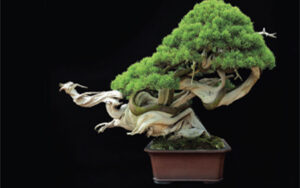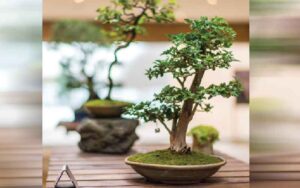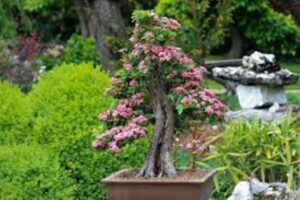KOKEDAMA : Creating Living Sculptures for Indoor Spaces
Introduction
Indoor gardening is gaining importance in this modern world as indoor plants add natural beauty, colour, and vibrancy to interior environments, creating a visually appealing and calming atmosphere. Kokedama is also one of the means of indoor gardening, which is a centuries-old Japanese form of garden art that is closely tied to the practice of bonsai. Kokedama’s term is derived from “Koke” which means moss, and “dama” which means ball.
Kokedama or Japanese moss ball is a favourite among plant decoration enthusiasts who are also passionate about sustainability. It is a decorative art of encasing a plant’s root in a ball of soil covered with moss. Kokedamasaren’t just trendy plant decor, they make the best gifts for plant lovers and are sustainable because they eliminate the use of plastic.
Kokedama involves wrapping the roots of a plant in moss and soil to create a unique, self-contained growing environment.In recent years, kokedamas have gained popularity in the Western world, with many people incorporating them into their homes as a unique way to display plants. Kokedamas are a great way to bring a touch of nature indoors, especially for those who are limited on space or prefer minimalistic decor. Kokedamasare often displayed in decorative arrangements or hung from ceilings as living art pieces.
History of Kokedamas
Kokedamas originated in Japan during the Edo period (1603-1868) as a way to display bonsai trees. Over time, the technique evolved to include a wider variety of plants and has become a popular form of Japanese gardening. Kokedamas are now enjoyed worldwide as a unique way to display plants and as an eco-friendly alternative to traditional potted plants.

Benefits of Kokedamas
Kokedamas offer several benefits, one of them is that they are an eco-friendly way to incorporate plants into home decor. Unlike traditional potted plants, kokedamas don’t require a plastic pot, which can contribute to waste. Additionally, kokedamas are typically made using sustainable materials, such as organic soil and moss.
They are often used as decorative pieces at homes and offices, and their unique appearance makes them a conversation starter. They require less watering than traditional potted plants due to the moisture retention properties of the moss ball and need low maintenance.
How to Make Kokedamas
Making a kokedama is a simple process that can be done with a few basic materials. Materials required are soil, moss, string or twine, and a plant of one’s choice. Mix the soil with water until it forms a mud-like consistency. Then the plant is depotted and gently remove excess soil from the roots. Take a handful of the mud-like soil already prepared and form it into a ball around the plant’s roots. Cover the soil ball with moss and wrap it tightly with string or twine to hold everything in place and to create a stable, self-contained plant.

The kokedama can then be displayed as desired in many creative ways, such as hanging from the ceiling, displayed on a shelf or table or arranged in a grouping to create a miniature indoor garden. They are also relatively easy to care for, requiring only occasional watering and indirect sunlight.
At College of Horticulture Chinalataripi B.Sc. (Hons.) Horticulture Students crafts Kokedama with Sansaveria, Fittonia, succulents like Haworthia, Ficus macrocarpa, pothos etc. under Experiential Learning Programme,Floriculture and Landscape Architecture programme. Kokedama made with Sansaveria and Ficus microcarpa performed well. They were customised with tripod stand made of bamboos, trinket tray and urn shaped plastic planter which enhanced the appearance and made it a good table decor.
Popular Plant Choices for Kokedamas
Almost any plant can be used for a kokedama, but the most important thing is to choose a plant that can handle being root-bound and doesn’t require too much water or maintenance. Some popular choices include
Ferns: Due to their have natural trailing habit ferns works well for hanging gardens. Some common ferns used include Boston ferns, Maidenhair ferns and Staghorn ferns.
Succulents: Succulents are also popular for kokedama because of low maintenance and can be handled being root-bound. Some common succulents used include String of Pearls, Jade Plants, and Haworthias.
Ivy: Ivy is a hardy plant that can adapt well to being grown in a kokedama. Common varieties used include English ivy and Variegated ivy.
Pothos: Pothos is another trailing plant that works well for kokedama. Common varieties used include Golden Pothos, Marble Queen Pothos, and Neon Pothos.
Spider Plants: Spider plants are known for their long, slender leaves that look great when grown in a hanging garden. The variegated variety is particularly popular for kokedama.
Tradescantia: Tradescantia, also known as spiderwort, is a colourful plant with thin, long leaves that add a splash of colour to a kokedama. Common varieties used include Tradescantia zebrina and Tradescantia fluminensis.

Orchids: Orchids can also be grown in a kokedama, particularly epiphytic orchids that naturally grow on trees. Common varieties used include Phalaenopsis orchids and Oncidium orchids.
Herbs: Some herbs can also be grown in a kokedama, including Basil, Thyme, and Mint. These plants can be harvested for cooking and add a fresh scent to your space.
However, ferns and orchids are popular choices due to their moisture-loving properties, while succulents and herbs are well-suited to dry conditions.
Conclusion
Kokedamas are a unique and attractive way to display plants that require basic materials for preparation, low maintenance, including their aesthetic appeal and eco-friendliness. Kokedamas are a fun and creative way to bring a touch of nature into your home or office as it is pretty easy to work.

















